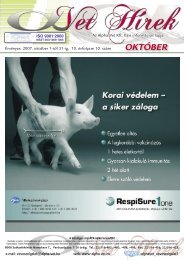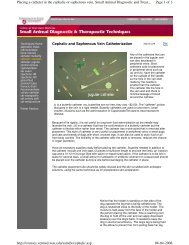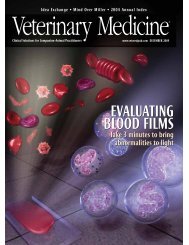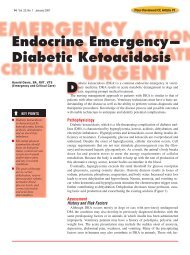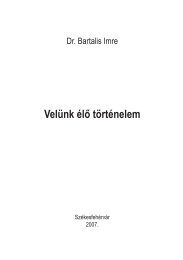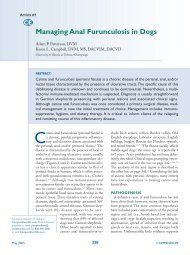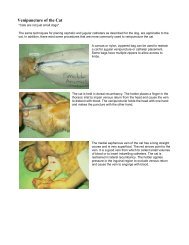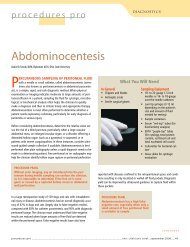Evaluation of the Importance of Centrifugation as a ... - Hungarovet
Evaluation of the Importance of Centrifugation as a ... - Hungarovet
Evaluation of the Importance of Centrifugation as a ... - Hungarovet
You also want an ePaper? Increase the reach of your titles
YUMPU automatically turns print PDFs into web optimized ePapers that Google loves.
<strong>Evaluation</strong> <strong>of</strong> <strong>the</strong> <strong>Importance</strong> <strong>of</strong><br />
<strong>Centrifugation</strong> <strong>as</strong> a Component <strong>of</strong> Zinc<br />
Sulfate Fecal Flotation Examinations<br />
Fifty canine fecal samples were evaluated by five flotation procedures to compare <strong>the</strong> sensitivity<br />
<strong>of</strong> <strong>the</strong> zinc sulfate (ZnSO4 ) centrifugation flotation test with ZnSO4 flotation tests using benchtop<br />
incubation during <strong>the</strong> flotation period. One or more par<strong>as</strong>ite species were detected in 40 samples.<br />
Results showed that centrifugation with ZnSO4 solution w<strong>as</strong> significantly more likely to<br />
detect a positive sample than benchtop procedures. The difference in procedures w<strong>as</strong> due<br />
primarily to incre<strong>as</strong>ed detection <strong>of</strong> Trichuris eggs and Giardia cysts by centrifugal flotation. No<br />
significant difference w<strong>as</strong> seen in <strong>the</strong> ability <strong>of</strong> benchtop procedures to detect positive samples<br />
when tests sat ei<strong>the</strong>r for 5 or 10 minutes before examination.<br />
J Am Anim Hosp Assoc 2002;38:221-224.<br />
Anne M. Zajac, DVM, PhD<br />
Jamil Johnson, BS<br />
Susan E. King, MT (ASCP)<br />
O<br />
From <strong>the</strong> Department <strong>of</strong> Biomedical Sciences<br />
and Pathobiology,<br />
Virginia-Maryland Regional College <strong>of</strong><br />
Veterinary Medicine,<br />
Virginia Tech,<br />
Blacksburg, Virginia 24061-0442.<br />
Address all correspondence to Dr. Zajac.<br />
Introduction<br />
The incre<strong>as</strong>ed awareness <strong>of</strong> canine and feline giardi<strong>as</strong>is in recent years<br />
h<strong>as</strong> contributed to practitioner interest in <strong>the</strong> use <strong>of</strong> 33% zinc sulfate<br />
(ZnSO4 ) fecal flotation solution when performing fecal examination for<br />
par<strong>as</strong>ites. This solution h<strong>as</strong> been recommended <strong>as</strong> an effective flotation<br />
solution for recovery <strong>of</strong> Giardia, because it produces less distortion <strong>of</strong><br />
cysts than o<strong>the</strong>r flotation solutions <strong>of</strong> higher specific gravity. 1,2 Generally,<br />
<strong>the</strong> ZnSO4 flotation test is described <strong>as</strong> a centrifugation procedure.<br />
1,2 However, b<strong>as</strong>ed on reports from practitioners, <strong>the</strong> ZnSO4 flotation procedure is also performed <strong>as</strong> a standard benchtop test, allowing<br />
<strong>the</strong> mixture <strong>of</strong> feces and ZnSO4 solution to sit in a pill vial or o<strong>the</strong>r<br />
container for a period <strong>of</strong> approximately 5 or 10 minutes before collecting<br />
<strong>the</strong> floated material for examination. In one commercial flotation kit<br />
that provides ZnSO4 <strong>as</strong> <strong>the</strong> flotation medium, a <strong>the</strong> package instructions<br />
direct <strong>the</strong> user to mix feces with flotation solution in <strong>the</strong> provided container<br />
and allow <strong>the</strong> mixture to sit for 5 or 10 minutes before inspection.<br />
The purpose <strong>of</strong> this study w<strong>as</strong> to determine if <strong>the</strong> benchtop ZnSO4 technique<br />
provides comparable results to <strong>the</strong> ZnSO4 centrifugation procedure.<br />
Additionally, a comparison w<strong>as</strong> made between results obtained by<br />
<strong>the</strong> ZnSO4 procedures and <strong>the</strong> Shea<strong>the</strong>r’s sugar centrifugal flotation<br />
technique to investigate whe<strong>the</strong>r 33% ZnSO4 flotation solution is <strong>as</strong><br />
effective in recovering common helminth eggs <strong>as</strong> a solution <strong>of</strong> higher<br />
specific gravity.<br />
Materials and Methods<br />
Fecal Samples<br />
Fifty fecal samples were used in <strong>the</strong> study. The samples were collected<br />
from dogs at <strong>the</strong> local animal shelter and from newly acquired research<br />
dogs (also originating from animal shelters) at <strong>the</strong> Virginia-Maryland<br />
Regional College <strong>of</strong> Veterinary Medicine. An effort w<strong>as</strong> made to collect<br />
samples from young dogs or dogs with diarrhea, with <strong>the</strong> expectation<br />
JOURNAL <strong>of</strong> <strong>the</strong> American Animal Hospital Association 221
222 JOURNAL <strong>of</strong> <strong>the</strong> American Animal Hospital Association May/June 2002, Vol. 38<br />
that <strong>the</strong>y were more likely to be fecal positive for par<strong>as</strong>itism<br />
than clinically normal adult dogs. In some c<strong>as</strong>es, fecal-positive<br />
dogs were sampled more than once on different days.<br />
Flotation Procedures<br />
Fecal samples were examined for par<strong>as</strong>ites within 24 hours<br />
<strong>of</strong> collection. Each sample w<strong>as</strong> thoroughly mixed, and five<br />
5-gram subsamples were taken. The subsamples were allocated<br />
to <strong>the</strong> following five groups: 1) 33% ZnSO4 centrifugal<br />
fecal flotation following <strong>the</strong> procedure used in <strong>the</strong><br />
diagnostic par<strong>as</strong>itology laboratory <strong>of</strong> <strong>the</strong> Virginia-Maryland<br />
Regional College <strong>of</strong> Veterinary Medicine Teaching Hospital<br />
(ZnSO4 VA Tech); 2) ZnSO4 flotation centrifugation using<br />
ZnSO4 provided in <strong>the</strong> Ov<strong>as</strong>say kit; a 3) ZnSO4 flotation <strong>as</strong><br />
described in <strong>the</strong> Ov<strong>as</strong>say kit with a 5-minute incubation; 4)<br />
same <strong>as</strong> Group 3, but with 10-minute incubation; 5)<br />
Shea<strong>the</strong>r’s sugar centrifugation flotation procedure. 2 All <strong>the</strong><br />
procedures were carried out by a single individual.<br />
Group 1, ZnSO 4 VA Tech procedure: The ZnSO 4 solution<br />
used in <strong>the</strong> diagnostic laboratory <strong>of</strong> <strong>the</strong> veterinary college is<br />
produced by mixing water and 33 grams <strong>of</strong> heptahydrate<br />
ZnSO 4 to a total volume <strong>of</strong> 100 mL. The specific gravity <strong>of</strong><br />
<strong>the</strong> final solution is checked with a hydrometer, and water or<br />
ZnSO 4 is added <strong>as</strong> needed to achieve a specific gravity <strong>of</strong><br />
1.18. The test is performed by mixing approximately 20 mL<br />
flotation solution to a 5-gram fecal sample and straining <strong>the</strong><br />
mixture through a double layer <strong>of</strong> cheesecloth into a 15-mL<br />
conical centrifuge tube. b Additional flotation solution is<br />
added to <strong>the</strong> tube to create a reverse meniscus, and a coverslip<br />
is placed on <strong>the</strong> top <strong>of</strong> <strong>the</strong> tube in contact with <strong>the</strong> flotation<br />
solution. The tube and coverslip are placed in a<br />
swinging bucket benchtop centrifuge b and spun for 5 minutes<br />
at 400 G. After <strong>the</strong> centrifuge comes to a complete stop,<br />
<strong>the</strong> coverslip is removed and microscopically examined.<br />
Group 2, ZnSO 4 centrifugation procedure using ZnSO 4 provided<br />
in <strong>the</strong> Ov<strong>as</strong>say kit: The test w<strong>as</strong> performed <strong>as</strong><br />
described for Group 1 (ZnSO 4 VA Tech), except that <strong>the</strong><br />
flotation solution w<strong>as</strong> prepared following <strong>the</strong> kit instructions.<br />
Water w<strong>as</strong> added to a me<strong>as</strong>ured amount <strong>of</strong> ZnSO 4 up<br />
to <strong>the</strong> line indicated on <strong>the</strong> bottle. The specific gravity <strong>of</strong><br />
<strong>the</strong> resulting solution w<strong>as</strong> approximately 1.2. No adjustment<br />
to <strong>the</strong> specific gravity w<strong>as</strong> made.<br />
Group 3, Ov<strong>as</strong>say ZnSO 4 procedure: Feces and ZnSO 4<br />
solution were mixed in a collection vial provided in <strong>the</strong> kit.<br />
A reverse meniscus w<strong>as</strong> formed with a coverslip placed on<br />
top, and <strong>the</strong> flotation mixture w<strong>as</strong> allowed to sit for 5 minutes<br />
in <strong>the</strong> vial before collection and examination.<br />
Group 4, Ov<strong>as</strong>say ZnSO 4 procedure: This procedure w<strong>as</strong><br />
performed <strong>as</strong> for Group 3, except <strong>the</strong> flotation mixture w<strong>as</strong><br />
allowed to sit for 10 minutes before examination.<br />
Group 5, Shea<strong>the</strong>r’s sugar centrifugation procedure: This<br />
centrifugation procedure w<strong>as</strong> performed <strong>as</strong> for Group 1,<br />
except Shea<strong>the</strong>r’s sugar solution 2 (specific gravity, 1.25)<br />
w<strong>as</strong> used <strong>as</strong> <strong>the</strong> flotation solution.<br />
At <strong>the</strong> end <strong>of</strong> each flotation procedure, <strong>the</strong> coverslip w<strong>as</strong><br />
collected, placed “wet” side down on a microscope slide,<br />
and systematically scanned using <strong>the</strong> 10× objective <strong>of</strong> a<br />
compound microscope (eyepiece magnification w<strong>as</strong> also<br />
10× for a total magnification <strong>of</strong> 100×). The 40× objective<br />
lens w<strong>as</strong> used for confirmation <strong>of</strong> Giardia cysts. Toxocara<br />
eggs, Trichuris, Ancylostoma, and Giardia cysts were<br />
counted up to a maximum <strong>of</strong> 300 per species per slide. The<br />
same student technician who performed <strong>the</strong> procedures also<br />
read each slide.<br />
Statistical Analysis<br />
For <strong>the</strong> positive samples for each par<strong>as</strong>itic species, <strong>the</strong><br />
GLIMMIX macro <strong>of</strong> <strong>the</strong> SAS systemc w<strong>as</strong> used to fit a generalized<br />
linear mixed model. Dogs were considered a random<br />
effect, and treatment solutions were considered a fixed<br />
effect. For egg counts <strong>of</strong> <strong>the</strong> positive samples, <strong>the</strong> MIXED<br />
procedure <strong>of</strong> SAS w<strong>as</strong> used to perform a mixed effects<br />
analysis <strong>of</strong> variance on <strong>the</strong> log counts. Single degree <strong>of</strong><br />
freedom contr<strong>as</strong>ts were used to test hypo<strong>the</strong>ses. For analysis<br />
<strong>of</strong> differences between centrifugal and noncentrifugal<br />
ZnSO4 techniques, results <strong>of</strong> <strong>the</strong> two centrifugation procedures<br />
were combined and compared to results <strong>of</strong> <strong>the</strong> combined<br />
benchtop procedures. Results were considered<br />
significant at P≤0.05.<br />
Results<br />
A total <strong>of</strong> 40 samples tested positive for one or more <strong>of</strong> <strong>the</strong><br />
following par<strong>as</strong>ites: Toxocara canis, Trichuris vulpis, Ancylostoma<br />
spp., and Giardia spp. Isospora oocysts were found<br />
in only one sample and so were not included in <strong>the</strong> analysis<br />
<strong>of</strong> results. No o<strong>the</strong>r par<strong>as</strong>ite species w<strong>as</strong> detected.<br />
The Table shows <strong>the</strong> number <strong>of</strong> samples that tested positive<br />
for each par<strong>as</strong>ite by <strong>the</strong> five flotation procedures. The<br />
ZnSO 4 VA Tech procedure detected par<strong>as</strong>ites in <strong>the</strong> greatest<br />
number <strong>of</strong> samples (n=39), followed by <strong>the</strong> Ov<strong>as</strong>say centrifugation<br />
procedure (n=33 positive samples), <strong>the</strong><br />
Shea<strong>the</strong>r’s sugar flotation technique (n=31 positive samples),<br />
Ov<strong>as</strong>say flotation for 5 minutes (n=25 positive samples),<br />
and Ov<strong>as</strong>say flotation for 10 minutes (n=24 positive<br />
samples). <strong>Centrifugation</strong> with ei<strong>the</strong>r ZnSO 4 or sugar solution<br />
w<strong>as</strong> significantly more likely to produce a positive<br />
result than <strong>the</strong> benchtop procedures (P
May/June 2002, Vol. 38 <strong>Centrifugation</strong> During Fecal Analysis 223<br />
nificantly greater for each par<strong>as</strong>ite in <strong>the</strong> combined ZnSO 4<br />
centrifugation procedures when compared to both ZnSO 4<br />
benchtop procedures (P
224 JOURNAL <strong>of</strong> <strong>the</strong> American Animal Hospital Association May/June 2002, Vol. 38<br />
<strong>the</strong> solution prepared from <strong>the</strong> kit w<strong>as</strong> always higher than<br />
<strong>the</strong> intended level <strong>of</strong> 1.18. This higher specific gravity may<br />
have distorted cysts in samples with low numbers, making<br />
<strong>the</strong>ir detection difficult. These results demonstrate <strong>the</strong> value<br />
<strong>of</strong> checking <strong>the</strong> specific gravity <strong>of</strong> flotation solutions. A<br />
hydrometer can be inexpensively purch<strong>as</strong>ed from a scientific<br />
supply company and is e<strong>as</strong>y to use.<br />
For all <strong>the</strong> helminth species detected, <strong>the</strong> number <strong>of</strong> eggs<br />
recovered in positive samples w<strong>as</strong> significantly greater with<br />
<strong>the</strong> ZnSO 4 centrifugation procedure than with <strong>the</strong> ZnSO 4<br />
benchtop procedure. It is likely that where par<strong>as</strong>ite egg<br />
numbers are low, <strong>the</strong> benchtop procedure may detect no<br />
eggs or only very few, which could be missed during a<br />
rapid scan <strong>of</strong> <strong>the</strong> coverslip. In this study, inaccuracies in<br />
data collected from samples with low egg numbers could<br />
have arisen from two sources. If low numbers <strong>of</strong> eggs were<br />
not evenly distributed throughout <strong>the</strong> sample, some subsamples<br />
may not have contained any eggs. Also, because this<br />
experiment w<strong>as</strong> not carried out <strong>as</strong> a blind study, <strong>the</strong> possibility<br />
<strong>of</strong> unconscious bi<strong>as</strong> cannot be excluded.<br />
The difference between benchtop and centrifugation<br />
ZnSO 4 techniques in recovery <strong>of</strong> Trichuris eggs w<strong>as</strong> particularly<br />
marked. The eggs <strong>of</strong> whipworms have a higher specific<br />
gravity (1.14) than o<strong>the</strong>r helminth eggs detected in <strong>the</strong>se<br />
tests (Toxocara, 1.09; Ancylostoma, 1.06) 8 and are less<br />
likely to complete <strong>the</strong>ir flotation in <strong>the</strong> short time permitted<br />
in <strong>the</strong> benchtop procedure. However, results <strong>of</strong> this study did<br />
not show that <strong>the</strong> Shea<strong>the</strong>r’s sugar flotation technique (specific<br />
gravity, 1.25) w<strong>as</strong> more effective in identifying whipworm-positive<br />
samples than ZnSO 4 centrifugation, although<br />
<strong>the</strong> geometric mean number <strong>of</strong> eggs/sample w<strong>as</strong> higher with<br />
<strong>the</strong> sugar flotation solution. The results add support to <strong>the</strong><br />
recommendation that ZnSO 4 is an effective routine flotation<br />
solution when <strong>the</strong> centrifugation procedure is used.<br />
The most desirable solution to use for routine screening<br />
flotation tests is one that is readily available and will allow<br />
<strong>the</strong> flotation <strong>of</strong> <strong>the</strong> greatest number <strong>of</strong> par<strong>as</strong>ite species without<br />
distortion. Unfortunately, those solutions with <strong>the</strong> highest<br />
specific gravities effectively float eggs <strong>of</strong> many<br />
helminth species but also distort and destroy par<strong>as</strong>ite eggs<br />
and cysts more rapidly than solutions <strong>of</strong> lower specific<br />
gravity. Clearly, no single flotation solution currently in use<br />
is best for recovering every par<strong>as</strong>ite found in small animal<br />
fecal samples. The 33% ZnSO 4 solution seems to <strong>of</strong>fer <strong>the</strong><br />
best balance for a simple screening test between effective<br />
flotation <strong>of</strong> common helminth eggs and protozoan cysts and<br />
oocysts. It is clear, however, that centrifugation <strong>of</strong> a flotation<br />
test produces significantly better results than benchtop<br />
incubation. This situation applies regardless <strong>of</strong> <strong>the</strong> flotation<br />
solution used, and every effort should be made in veterinary<br />
practices to perform this test <strong>as</strong> a centrifugation procedure.<br />
The procedures in this study used a swinging bucket<br />
centrifuge. However, fixed-angle centrifuges are probably<br />
more common in veterinary practices. These fixed-angle<br />
centrifuges can also be used for flotation procedures with a<br />
slight modification <strong>of</strong> <strong>the</strong> technique. Centrifuge tubes<br />
should be filled <strong>as</strong> full <strong>as</strong> possible without spilling when<br />
placed in <strong>the</strong> angled rotor. After centrifuging <strong>the</strong> tube, <strong>the</strong><br />
top layer <strong>of</strong> fluid can be ga<strong>the</strong>red in two ways. A microbiological<br />
loop or <strong>the</strong> rounded bottom <strong>of</strong> a small gl<strong>as</strong>s tube<br />
(such <strong>as</strong> an empty blood-collection tube) can be touched to<br />
<strong>the</strong> surface <strong>of</strong> <strong>the</strong> liquid in <strong>the</strong> tube after centrifugation. The<br />
loop or tube is <strong>the</strong>n touched to a microscope slide, and a<br />
drop or two <strong>of</strong> fluid is deposited. A coverslip should be<br />
added and <strong>the</strong> slide examined. Alternatively, <strong>the</strong> tube can be<br />
removed from <strong>the</strong> centrifuge after spinning and <strong>the</strong>n placed<br />
in a test-tube rack. Additional flotation solution is added<br />
until a reverse meniscus forms, and <strong>the</strong>n a coverslip is<br />
placed on top. The tube is allowed to sit for an additional 5<br />
minutes to allow par<strong>as</strong>ite eggs to float <strong>the</strong> rest <strong>of</strong> <strong>the</strong> distance<br />
to <strong>the</strong> coverslip. The coverslip is <strong>the</strong>n removed and<br />
placed on a microscope slide <strong>as</strong> described for this study.<br />
Centrifuges commonly found in veterinary practices also<br />
provide adequate force for centrifugal flotations. As a general<br />
guideline, centrifuging a tube at <strong>the</strong> same speed used<br />
for spinning blood or urine should be sufficient for flotation<br />
procedures. 2<br />
Practitioners and technicians may argue that centrifugation<br />
adds inconvenience to <strong>the</strong> simple flotation test, but<br />
maximizing <strong>the</strong> sensitivity <strong>of</strong> this common laboratory procedure<br />
will improve detection and treatment <strong>of</strong> par<strong>as</strong>itic<br />
infections in companion animals.<br />
a Ov<strong>as</strong>say; Synbiotics Corp., San Diego, CA<br />
b Fisher Scientific Company, Pittsburgh, PA<br />
c Version 8.0; SAS Institute, Inc., Cary, NC<br />
Acknowledgments<br />
The authors acknowledge Synbiotics Corporation for <strong>the</strong><br />
donation <strong>of</strong> Ov<strong>as</strong>say kits used in <strong>the</strong> study, <strong>the</strong> Minority<br />
Access Opportunity Program at Virginia Tech for support <strong>of</strong><br />
this study, and <strong>the</strong> <strong>as</strong>sistance <strong>of</strong> Daniel Ward in statistical<br />
analysis <strong>of</strong> <strong>the</strong> data.<br />
References<br />
11. Kirkpatrick CE. Giardi<strong>as</strong>is. In: Grieve RB, ed. Par<strong>as</strong>itic infections. Vet<br />
Clin North Am: Sm Anim Pract. Philadelphia: WB Saunders,<br />
1987;17:1377-1387.<br />
12. Zajac AM. Fecal examination in <strong>the</strong> diagnosis <strong>of</strong> par<strong>as</strong>itism. In: Sloss<br />
MW, Kemp RL, Zajac AM. Veterinary clinical par<strong>as</strong>itology. 6th ed.<br />
Ames, Iowa: Iowa State Univ Press, 1994:3-16.<br />
13. Koutz FR. A comparison <strong>of</strong> flotation solutions in <strong>the</strong> detection <strong>of</strong> par<strong>as</strong>ite<br />
ova in feces. Am J Vet Res 1941;2:95-100.<br />
14. Barr SC, Bowman DB. Giardi<strong>as</strong>is in cats and dogs. Comp Cont Ed<br />
Pract Vet 1994;16:603-616.<br />
15. Thompson RCA, Hopkins RM, Homan WL. Nomenclature and<br />
genetic groupings <strong>of</strong> Giardia infecting mammals. Par<strong>as</strong>itol Today<br />
2000;16:210-212.<br />
16. Faust EC, Sawitz W, Tobie J, Odom V, Peres C, Lincicome DR. Comparative<br />
efficiency <strong>of</strong> various techniques for <strong>the</strong> diagnosis <strong>of</strong> protozoa<br />
and helminths in feces. J Par<strong>as</strong>itol 1939;25:241-262.<br />
17. Otto GF, Hewitt R, Strahan D. A simplifed zinc sulfate levitation<br />
method <strong>of</strong> fecal examination for protozoan cysts and hookworm eggs.<br />
Am J Hyg 1941;33:32-37.<br />
18. David ED, Lindquist WD. Determination <strong>of</strong> <strong>the</strong> specific gravity <strong>of</strong><br />
certain helminth eggs using sucrose density gradient centrifugation.<br />
J Par<strong>as</strong>itol 1982;68:916-919.




